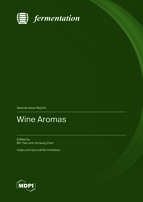Wine Aromas
A special issue of Fermentation (ISSN 2311-5637). This special issue belongs to the section "Fermentation for Food and Beverages".
Deadline for manuscript submissions: closed (31 October 2022) | Viewed by 33546
Special Issue Editors
Interests: wine chemistry; wine microbiology; food science
Special Issues, Collections and Topics in MDPI journals
Interests: fermented alcoholic beverages; winemaking; wine chemistry; biochemistry and molecular biology of grapes; food sensory analysis
Special Issues, Collections and Topics in MDPI journals
Special Issue Information
Dear Colleagues,
Wine is a complex matrix with many volatile compounds present and evolving over time. These volatile compounds are important to wine quality as they contribute to the aroma and varietal characteristics of wine. Recent development in the analysis of volatile compounds in wine has greatly improved our understanding of the complexity of wine aroma. Analytical methods used for wine aroma fingerprinting have shown the potential to determine the origin and quality of wine. Thus, research on volatile compounds responsible for wine aroma and their correlation with wine provenance and wine quality have increasingly attracted great interest of researchers and winegrowers. This special issue aims to present the latest research regarding the wine aroma compounds, and we welcome manuscripts on topics including but not limiting to the characterization of aroma compounds in grapes and wine, factors influencing the production of aroma compounds in wine during fermentation and maturation, and analytical methods for wine aroma analysis.
Dr. Bin Tian
Prof. Dr. Jicheng Zhan
Guest Editors
Manuscript Submission Information
Manuscripts should be submitted online at www.mdpi.com by registering and logging in to this website. Once you are registered, click here to go to the submission form. Manuscripts can be submitted until the deadline. All submissions that pass pre-check are peer-reviewed. Accepted papers will be published continuously in the journal (as soon as accepted) and will be listed together on the special issue website. Research articles, review articles as well as short communications are invited. For planned papers, a title and short abstract (about 100 words) can be sent to the Editorial Office for announcement on this website.
Submitted manuscripts should not have been published previously, nor be under consideration for publication elsewhere (except conference proceedings papers). All manuscripts are thoroughly refereed through a single-blind peer-review process. A guide for authors and other relevant information for submission of manuscripts is available on the Instructions for Authors page. Fermentation is an international peer-reviewed open access monthly journal published by MDPI.
Please visit the Instructions for Authors page before submitting a manuscript. The Article Processing Charge (APC) for publication in this open access journal is 2600 CHF (Swiss Francs). Submitted papers should be well formatted and use good English. Authors may use MDPI's English editing service prior to publication or during author revisions.
Keywords
- ageing
- aroma
- bacteria
- fermentation
- grape
- varietal characteristics
- wine
- yeast






